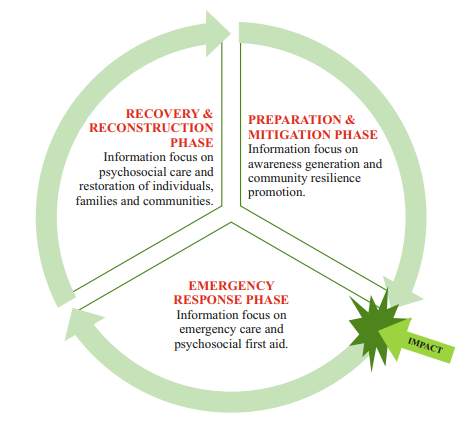Disaster Risk Communication
Disaster Risk Communication
Disaster Risk Communication (DRC) helps in empowering the disaster-prone communities with knowledge and skills to mitigate disaster impact. DRC is an ongoing process that can be implemented before, during and after any disaster. Effective communication can be ensured by initiating interactive communication flow between the system and the beneficiaries. The importance of DRC and integrating the same with community preparedness activities has got much attention in recent years. The disturbing off shoots of disaster can be managed or minimised through prior DRC. Hence, it should not only aim at providing risk information to individuals/communities but also empower them to adapt appropriate strategies at individual and community levels.

Steps in DRC Planning and implementation
 Step 1 – Design
Step 1 – Design
- Talk to the community and understand the purpose.
- Assess the target population (their knowledge, language & culture).
- Decide upon the medium for providing information on risk.
- Plan schedule for communication.
- Develop tools to assess the impact of DRC.
Step 2 - Pre-test
- Provide the developed information to a sample of population.
- Evaluate the impact of the communication.
- Do modifications if necessary.
Step 3 - Implement
- Coordinate with community people and other voluntary organisations.
- Use the pre-decided mediums and drive disaster risk communication.
Step 4 - Evaluate
- Analyse whether the field level implementation has achieved the purpose.
- Look for change in indicators (knowledge, attitude, beliefs and practices).
- Replicate or relook DRC based on the evaluation.
Step 5 - Make a policy
- Based on the results of the evaluation, create policy level changes for sustainability of the intervention on DRC in the community.
Medium for DRC.
- Individual and group interaction
- Announcements through loud speakers
- Telephonic conversation
- Radio, Television, Internet
- SMS, caller tunes
- Social Media
- Training of local information ambassadors
- Helpline services
- Written notices
- Use of folk arts
- Community campaigns
Importance of DRC in different phases
Preparedness
- Collaborate with local community and governmental/nongovernmental organisations.
- Provide consistent information repeatedly.
- Use appropriate media.
- Be open, clear and honest.
- Respect the community’s local sentiments.
- Use understandable and appropriate language.
- Deliver prompt and authentic information.
- Enforce rumour reduction/prevention measures.
Response
- Ensure communication to enhance hope, security and social connectivity.
- Use crisp and clear communication.
- Avoid flooding of disturbing materials.
- Use affirmative and self-reliance instilling information.
- Have a check on rumours and focus on minimising them.
Recovery
- Build awareness and instil hope.
- Communicate on work done and intended plan of action.
- Maintain transparency.
- Emphasis on community participation and ownership.
- Provide authentic information on rebuilding services.
- Deliver information on alternative living strategies.
- Give opportunities for transparent feedback.
Outcomes of DRC
- Educates people on risks, hazards, vulnerabilities and existing capacities.
- Instils community belongingness, participation and cohesiveness.
- Unveils innovative, local, cost effective, culturally specific prevention or mitigation measures.
Last Modified : 11/29/2023
This topic provides information about Emergency He...
Provides summary of District Disaster Management P...
This topic covers the information about National D...
This topic covers the information about Policies a...
